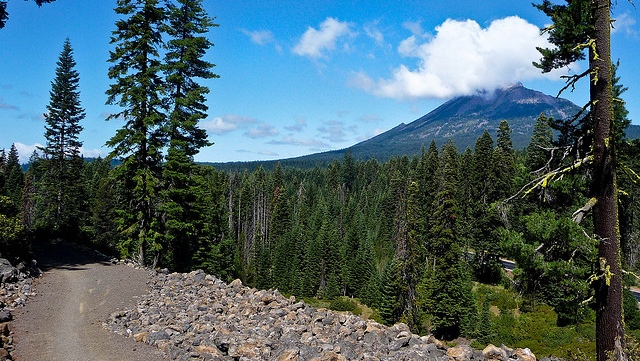My running completely transformed during my Junior year of high school. It hasn’t been the same since that year, when I transitioned a majority of my training to the trails.
Yes, trail running changed my approach to running.
It reinforces my belief that running by feel is more effective.
Trail running makes the hard work of 85+ miles per week easier to accomplish.
When done right, running on trails can reduce your injury risk and make you a stronger runner.
It’s brought me countless adventures, like exploring sugar cane fields on Maui or seeing a glacier in New Zealand.
None of this would have been possible without trail running.
Yet many runners are hesitant to get off the roads and onto the trails because they fear injuries from sprained ankles or envision technical trails in the mountains.
But trail running doesn’t have to be difficult. It can be enjoyable, stress-free, and a valuable part of your training program.
Today I want to show you how you can get started with an exclusive interview with Olympian and Runner’s World columnist Jeff Galloway.
Trail Running with Jeff Galloway: What You Need to Know
Jeff ran the 10,000m at the 1972 Olympics, is currently a Runner’s World columnist, and wrote the new book Trail Running: The Complete Guide. In it he explains:
- The ins and outs of running on any surface
- Training plans for every situation
- How to choose the best trails and trail running equipment
- 30+ chapters on speed development, injury prevention, and diet for runners
You might remember Jeff as the author of 19 books (!) on running, walking, fat-burning, and exercise. He’s also the inventor of the run-walk-run method to help beginners get started with running.
Now let’s see how to get acquainted with trail running, what mistakes to avoid, and how to avoid falling on your face.
Disclaimer: falling will happen sooner or later. I’m good for 2-3 epic falls every year; the only thing that gets hurt is my ego.
I’ve included my thoughts underneath Jeff’s answers so it’s more like a discussion. Enjoy!
Does running on the trails require changes to your running form?
Jeff: For stability and to effectively navigate over rocks, sticks, and holes it’s best to run with a short stride. With a longer stride, you’ll be less stable when landing. Shorter strides make it easier for the foot to land directly underneath the body, reducing instability as the feet sense how to adjust to the ground.
Being totally focused on the surface will also reduce the chance of tripping, slamming into an obstacle, aggravating an ankle, or falling.
Jason: I can’t agree more. To quote Caballo Blanco from Christopher McDougall’s bestseller Born to Run:
If you’re debating between one or two steps between rocks, take three.
The point is that a short, quick stride makes you more responsive to obstacles and uneven terrain. Combined with being more mindful of the trail, you’ll fall less frequently and run more economically (in other words, you’ll be more efficient so it feels easier).
How can beginners choose a good trail? What should they do on their first trail run?
Jeff: Beginners should be careful choosing their first trail. There are many links in my book Trail Running and it helps to get advice from experienced trail runners in the area.
At first, pick trails with a fairly stable surface – not too hilly and without too many cross-trail junctions (to avoid getting lost). Bring a cell phone just in case and if possible, run with a companion.
Jason: This is where most runners get confused about the definition of “trail” running. Think about it as off-road running instead – any off-road surface can be considered a trail so beginners can get started on smooth, stable surfaces like cinder walking paths, firm grass, or smooth dirt trails with very few obstacles.
A trick I use to find off-road running whenever I travel is to look at Google Maps and note any green areas. These parks often have trail systems or other ways of avoiding the road. As the Kenyans say:
Hard roads kill fresh legs.
What top mistakes do road runners make when they start trail running?
Jeff: The first mistake is that their stride length is too long. Because of trail hazards like rocks, sticks, holes, uneven surfaces that change from step to step, a runner gains more stability by shortening the stride and having the foot land underneath their center of mass.
The natural stride of a road runner has been embedded in the subconscious brain and they often maintain this stride when venturing onto the trails. This can result in more ankle injuries, less stability, and more falls.
The second mistake is that runners bounce too much while trail running. By staying low to the ground while still clearing debris, trail runners have better control over foot movement. Road runners tend to bounce a bit higher and are often surprised by foot instability as they land.
Finally, many runners go too fast on the downhills. Roads offer a smooth surface with few irregularities and road runners tend to run faster because of gravity and momentum. This speed on the trails doesn’t allow for careful placement of the feet around rocks and other obstacles.
Jason: Trail runners often run by effort rather than a strict pace. Beginners who are just getting started with trail running may want to stop using their GPS watch – pace isn’t as important as your overall effort, which will be higher because of the terrain, obstacles, and elevation changes.
Running slower isn’t just a good idea because of effort. You’ll also be able to pay more attention to the trail itself and enjoy the scenery.
Are trail running shoes necessary?
Jeff: Most of the trail runners I know run most of their trail runs with regular training shoes. If the surface is very technical or slippery, you may want a trail shoe. With a lot of gravel or sharp sticks or rocks, it helps to have protection on the sole of the shoe. Trail shoes have this, as do some regular training shoes.
Jason: I’ll echo Jeff’s sentiment 100%. I run the majority of my mileage on trails – and so did my entire college cross country and track teams – and almost none of us wear trail shoes. They can be helpful in some extreme situations, but if you’re just getting started you don’t have to worry about specific shoes for trail running.
Most road shoes will work fine. But of course, some are more stable and suitable for trails, so do your research with some good running shoe reviews before buying.
Improve Your Running Today – Start Trail Running!
A big thank you to Jeff Galloway for answering our questions about trail running! Please join me in saying thanks in the comment section below.
You can check out his new book, Trail Running: The Complete Guide here.
After reading this interview, are you going to keep running on the roads? I hope not.
Ditch the cement, asphalt, stop lights, traffic, and pollution and hit the trails!
